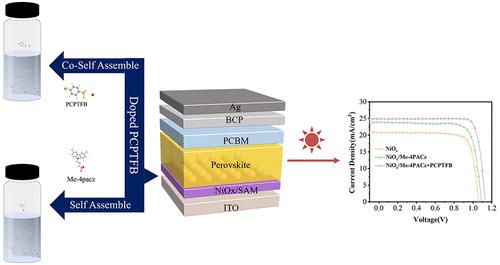Bimolecular Passivation Layer Modified NiOx to Improve the Efficiency and Stability of Perovskite Solar Cells
IF 8.2
2区 材料科学
Q1 MATERIALS SCIENCE, MULTIDISCIPLINARY
引用次数: 0
Abstract
NiOx as a hole transport layer (HTL) for inverted perovskite solar cells (PSCs) shows significant commercialization prospects for enhancing device efficiency. However, limited by the problem of defects at the interface between perovskite and NiOx, achieving effective interfacial passivation still faces many challenges. In this study, Me-4PACz is doped with potassium 4-chlorophenyl trifluoroborate (PCPTFB) to form a co-self-assembled monolayer (Co-SAM) to modify the buried interface of PSCs. The system effectively passivates NiOx surface defects by PCPTFB, optimizes the Ni3+/Ni2+ ratio, enhances the hole extraction capability, and improves the energy band matching. In addition, PCPTFB synergistically stabilized the perovskite interface, reduced nonradiative recombination, and promoted the formation of high-quality perovskite films. Based on the above optimization, the Me-4PACz+PCPTFB modified device achieved an excellent photoelectric conversion efficiency (PCE) of 23.68%. For the stability test, the unencapsulated PSCs maintained an initial efficiency of 90% after 1400 h of aging in a nitrogen environment, demonstrating excellent long-term stability. This innovative strategy not only highlights the important role of Me-4PACz+PCPTFB in NiOx/perovskite interfacial engineering but also provides a new technological path to realize efficient and stable PSCs.

双分子钝化层修饰氧化镍提高钙钛矿太阳能电池的效率和稳定性
作为倒钙钛矿太阳能电池(PSCs)的空穴传输层(HTL), NiOx在提高器件效率方面具有重要的商业化前景。然而,受钙钛矿与NiOx界面缺陷问题的限制,实现有效的界面钝化仍然面临许多挑战。在本研究中,Me-4PACz掺杂了4-氯苯基三氟硼酸钾(PCPTFB),形成了一个自组装的单层(Co-SAM),以修饰PSCs的埋藏界面。该体系通过PCPTFB有效钝化了NiOx表面缺陷,优化了Ni3+/Ni2+比,提高了抽孔能力,提高了能带匹配。此外,PCPTFB协同稳定了钙钛矿界面,减少了非辐射复合,促进了高质量钙钛矿膜的形成。基于上述优化,Me-4PACz+PCPTFB修饰器件获得了23.68%的优异光电转换效率(PCE)。在稳定性测试中,未封装的psc在氮气环境中老化1400 h后仍保持90%的初始效率,表现出优异的长期稳定性。这一创新策略不仅突出了Me-4PACz+PCPTFB在NiOx/钙钛矿界面工程中的重要作用,而且为实现高效稳定的PSCs提供了新的技术途径。
本文章由计算机程序翻译,如有差异,请以英文原文为准。
求助全文
约1分钟内获得全文
求助全文
来源期刊

ACS Applied Materials & Interfaces
工程技术-材料科学:综合
CiteScore
16.00
自引率
6.30%
发文量
4978
审稿时长
1.8 months
期刊介绍:
ACS Applied Materials & Interfaces is a leading interdisciplinary journal that brings together chemists, engineers, physicists, and biologists to explore the development and utilization of newly-discovered materials and interfacial processes for specific applications. Our journal has experienced remarkable growth since its establishment in 2009, both in terms of the number of articles published and the impact of the research showcased. We are proud to foster a truly global community, with the majority of published articles originating from outside the United States, reflecting the rapid growth of applied research worldwide.
 求助内容:
求助内容: 应助结果提醒方式:
应助结果提醒方式:


